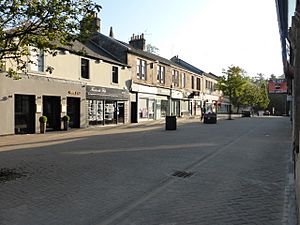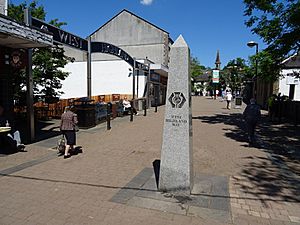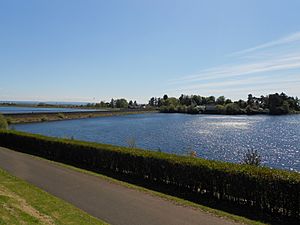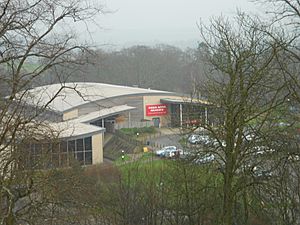Milngavie facts for kids
Quick facts for kids Milngavie
|
|
|---|---|
 Milngavie town centre (pedestrianised area) |
|
| Population | 12,840 (2020) |
| OS grid reference | NS553744 |
| Council area | |
| Lieutenancy area | |
| Country | Scotland |
| Sovereign state | United Kingdom |
| Post town | GLASGOW |
| Postcode district | G62 |
| Dialling code | 0141 |
| Police | Strathclyde |
| Fire | Strathclyde |
| Ambulance | Scottish |
| EU Parliament | Scotland |
| UK Parliament |
|
| Scottish Parliament |
|
Milngavie (pronounced "mul-GHY") is a town in East Dunbartonshire, Scotland. It's like a suburb of Glasgow, located about 10 kilometres (6 miles) from the city centre. The town sits by the Allander Water river and is right next to another town called Bearsden.
Many people who live in Milngavie travel to Glasgow for work or school. This makes it a "commuter town." You can easily get to Glasgow by train from Milngavie railway station. In 2018, about 13,537 people lived in Milngavie. It's also a popular place for older people to retire.
The local newspaper, the Milngavie and Bearsden Herald, shares news about schools, community events, and local government. It started in 1901 and comes out every Wednesday.
Milngavie is famous as the starting point of the West Highland Way. This is a long walking path that stretches 154 kilometres (96 miles) north to Fort William. A special stone monument (called an obelisk) in the town centre shows where the path officially begins.
Contents
History of Milngavie
The name Milngavie comes from a Scottish Gaelic phrase. It might mean "windmill" (muileann gaoithe) or "windy hill" (meall na gaoithe).
Milngavie started as a small country village. In the 1800s, it grew into a small industrial hub. There were paper mills and bleach works along the Allander River. You can still see some signs of this industrial past today.
Wealthy people started building nice stone houses in Milngavie. This happened after the railway opened in 1863, making it easy to travel to Glasgow. After World War II, new homes were built for people who had lost their houses in Clydebank during the war. More houses were built in the 1950s and 1960s, helping the town grow even more.
Milngavie used to have a tram system, which was part of the big Glasgow tram network. The trams stopped running in Milngavie in 1956.
In the 1970s, the town centre was updated to make it safer for walkers and improve traffic flow. Many old buildings were replaced. In the 1990s, a large supermarket opened near the town centre.
In 2008, some residents had a fun idea: they started a playful campaign to bring the Olympic Games to Milngavie in 2020! Today, Milngavie is mostly a town where people live and travel to Glasgow for work.
How Milngavie is Governed
Milngavie was once part of Stirlingshire. Later, it became a special part (an "exclave") of Dunbartonshire by order of King David II long ago.
From 1875, Milngavie was a "police burgh," meaning it had its own local police and government. This lasted for 100 years until 1975. Then, it became part of a larger area called the Strathclyde Region.
Milngavie is very close to Bearsden. Even though they are neighbours, they grew in different ways. Bearsden mostly grew as a place for wealthy people to live and commute to Glasgow. Now, both towns serve a similar purpose. In 1975, Milngavie and Bearsden became one local government district. Later, in the 1990s, they joined with Kirkintilloch and Bishopbriggs to form the East Dunbartonshire area we know today.
In 2014, businesses in Milngavie decided to become a "Business Improvement District" (BID). This means they work together with the East Dunbartonshire Council to make the town better and help local businesses succeed.
Important Landmarks
Not many buildings from before the 1800s are left in Milngavie. Some older buildings include the Corbie Ha' meeting hall, the Cross Keys Public House (though it's been updated), and Gavin's Mill, an old water mill on the Allander Water. Barloch House and Barloch Farm are also old buildings.
You can see some beautiful stone houses from the 1800s along Station Road and near the old railway station. Around Tannoch Loch, there are many interesting Victorian houses. They show different styles like Scottish cottage, Scottish Baronial, Classical architecture, and Gothic. The town centre also has Victorian shop buildings.
Most of Milngavie's houses were built in the 1900s. They often use traditional Scottish styles, like rough-cast walls. Some also have English features, like black and white timber panels.
The public housing projects from the 1970s and 1980s are interesting. They tried to use local materials like grey rough-cast and slate, and they have unique rounded walls and pitched roofs. Newer buildings include modern homes and steel-framed commercial buildings.
The Milngavie reservoir is a popular spot for visitors and walkers. It has two parts: the Craigmaddie and Mugdock reservoirs. Queen Victoria opened it in 1859. This reservoir is the main source of water for Glasgow and can hold a huge amount of water – about 548 million gallons!
The town also has a war memorial designed by George Henry Paulin. The Auld Wives' Lifts, a cool natural rock formation, can be found on Craigmaddie Muir, just northeast of Milngavie.
Schools in Milngavie
Secondary Schools
- Douglas Academy: This is a state-funded high school. It also has a special Music School for talented students who pass an audition.
Primary Schools
State-funded (free to attend):
- Clober Primary
- Craigdhu Primary
- Milngavie Primary
Privately-funded (fee-paying):
- The Glasgow Academy Milngavie: This school offers nursery and primary education. It's part of The Glasgow Academy, which has its main high school in Glasgow.
Places of Worship
Milngavie has several churches:
- Allander Evangelical Church
- Cairns Church of Scotland
- Milngavie United Free Church of Scotland
- St. Andrew's Episcopal Church
- St. Joseph's Roman Catholic Church
- St. Luke's Church of Scotland
- St. Paul's Church of Scotland
Historically, Milngavie didn't have its own church until the 1700s. People went to the church in nearby Bearsden. Today, Milngavie has three stone churches built in the early 1900s very close to each other. These were all Church of Scotland congregations at one point.
St. Paul's Church is now the main parish church for Milngavie. It moved to its current red sandstone building in 1906. Cairns Church moved to its current building in 1903. St. Luke's was originally built as the Milngavie United Free Church. In the 1970s, a new St. Luke's Church was built on the west side of town. The Roman Catholic Church then bought the old St. Luke's building for their St. Joseph's congregation.
Sports in Milngavie
Milngavie is home to many sports clubs and facilities. Rangers F.C. has its professional training ground, The Rangers Training Centre, in the east of the town. It opened in 2001 and cost about £14 million. This facility is now used for competitive matches by Rangers' women's, reserve, and youth teams. A new stand for spectators opened in 2019.
Milngavie is also where West of Scotland F.C., a rugby club, is based. This club started in 1865 and was one of the first rugby clubs in Scotland not linked to a school.
Other sports facilities include:
- Allander Leisure Centre
- Milngavie Cricket Club
- Milngavie Bowling Club
- Claremont Bowling Club
- Clober Golf Club
- Milngavie Golf Club
- Milngavie Wanderers AFC
- Nuffield Health Fitness and Wellbeing
- Hilton Park Golf Club
- Glasgow Vipers Inline Hockey Club
- Sports Direct Fitness.com
- Milngavie Lawn Tennis Club
- Western Wildcats Hockey Club
- Milngavie Football Club
- Milngavie and Bearsden Amateur Swimming Club
Famous People from Milngavie
- Robert McLellan: A playwright who grew up in Milngavie. His father started a local printing press there.
- Murdo MacLeod: A famous footballer who played for teams like Celtic and Borussia Dortmund, and for Scotland. He was born and raised in Milngavie.
- Jo Swinson: A former leader of the Liberal Democrat political party in the UK. She was born and grew up in Milngavie and went to Douglas Academy.
- Prof Edward Eisner FRSE: A professor from the University of Strathclyde who lived in Milngavie.
- Gerry Birrell: A racing car driver who was born and raised in Milngavie.
- Margaret Cunnison: A Scottish aviator (pilot) and the first Scottish woman flying instructor. She was also one of the first women to join the Air Transport Auxiliary during the war.
See also
- Milngavie water treatment works
- Bennie Railplane
- List of places in East Dunbartonshire
- List of places in Scotland





